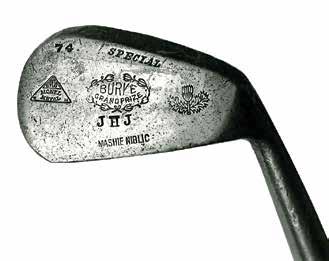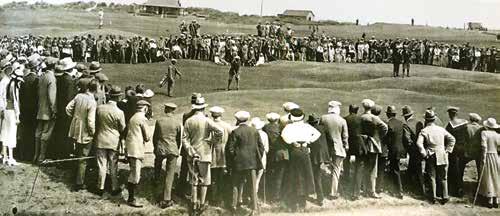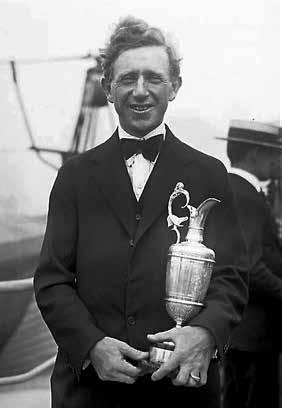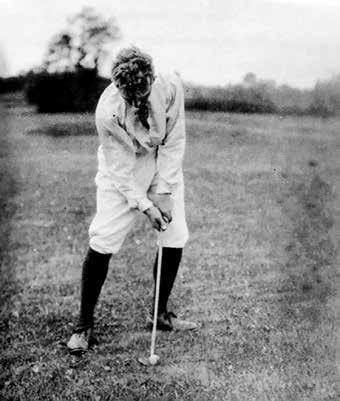
9 minute read
Deep Groove Demise, by Jim Davis
Deep Groove Demise
“...buying the shot out of the shop.”
Advertisement
JH TAYLOR British golfing legend
By Jim Davis
The year was 1921 and there was a lot going on. Russia was deep in a Great Famine, the IRA and Great Britain agreed to a ceasefire and the Irish Free State created, Albert Einstein was awarded the Nobel Prize in physics, a race riot rocked Tulsa, Okla., and the U.S. and Germany signed the Treaty of Berlin, which formally ended their WWI hostilities.
In sports, the Chicago White Sox were accused of throwing the World Series (“Say it ain’t so, Joe!), and Babe Ruth hit his 138th home run, a record for career homers. Over in Scotland there was tension over the Open Championship at St. Andrews.
It had been brewing for some time and partly concerned the use of the so-called “deep groove” face treatments of golf clubs, then referred to as “ribbed face” or “corrugated” clubs.
Jock Hutchison, a talented Scottish immigrant who won the 1921 Open, carried more than a few. His “Stoppums,” as he called them, all Burke models, were thought to have given him an unfair advantage, testing the patience of the R&A championship committee whose favorite, Roger Wethered, lost to Hutchison in a 36-hole playoff. Those darn clubs!
In 1902, a man named E. Burr patented a deeply scored face for the purpose of back spin. (Now, there was a fellow who had the high handicapper in mind.) For whatever reason, though, the clubs failed to catch on. Still, in an era of golf experimentation, you just knew that something would come up. It did in 1913 when Ben Sayers designed his deeply ribbed “Stoppum” irons, forged by Hendry & Bishop of Edinburgh. His brother, George, sold them through his golf shop in Pennsylvania.
While Sayers failed to truly capitalize on the design, other manufacturers were quick to do so, especially the Americans who were never shy about making a buck on a trendy item. Between then and 1921, all manner of brands and names hit the market.
Pete Georgiady’s Collecting Antique Golf Clubs guide identifies several of these, mostly American-made as World War I limited British club makers in the availability of materials and production. The variety and names also attest to the American ingenuity for clever marketing – Backspin, Stop’em, Hold-em, Shur-stop, Short Stop, Dedli, Checkrite, and Gyroscope – to name a few.

Jack Fowler Hutchison, and his brother, Tom, were among the wave of Scottish golf professionals immigrating abroad for career opportunities. Tom would come to the U.S. to work for the wealthy Carnegie family. Jock (as “Jack” became in Scotland), in 1903, traveled to Australia where he worked for a sporting goods company and helped design the “New Course” for the Australian Golf Club.
In 1905, Jock came to the U.S. to work for the WC Carnegie family, taking up virtually the same position as his brother who had died in a tragic accident in 1900 while working to design a golf course on the family’s property on Cumberland Island off Georgia. The story goes that in 1906 Andrew Carnegie helped Jock secure the post of professional at the St. Andrews GC near New York. In 1909, he moved to the
champion clubs. Jock Hutchison used the Burke Grand Prize models mashie and 74 mashie niblick during his Open victory, according to antique club expert Pete Georgiady. “After his win Burke sold those irons as Jock Hutchison autograph models H-6 and H-7,” he says.
cOntinuED fROm 17 Pittsburgh GC and then to Allegheny GC in 1911. While here, Jock received some valuable lessons from Macdonald Smith who was the professional at nearby Oakmont CC.
Over his long career, Jock would win many important golf championships, establishing a name as one of the game’s finest players. In 1916, he finished second to Jim Barnes in the roger wethered putts, above, while Jock Hutchison and inaugural PGA championship at Si- his caddie look on during their 36-hole playoff for the 1921 wanoy CC then moved to Glen View Open Championship. At right, Jock with the Claret Jug. Club in Golf, Ill. where he would serve as professional for the rest of his ca- place on Jan. 1. 1922. Thus reer. He filed for U.S. citizenship in 1917, the naturalization came to end the cessation becoming official in early 1920. Also in 1920, he won the of war against par with PGA Championship and the Western Open, then considered deep groove clubs and a a major. new class of golf collectible was born. Nowadays
In 1921, the PGA of America picked a 12-man team to the only place you will find play in the Open Championship at St. Andrews, the first such these clubs is in the bags of team to be so chosen for this event. Among those on the team SoHG members who find with Jock were Walter Hagen, Fred McLeod, and Bill Mel- their novelty more charmhorn. ing than their effectiveness
For years Jock had been experimenting with ribbed face at stopping balls on the clubs, building a set that he was quite happy with. He ar- green. rived for the 1921 Open Championship at the height of (Deep groove clubs continued to be sold for awhile afdeep groove popularity, but probably knowing full well of ter the ban, as players loved them for casual play, they just the R&A’s decision to ban the clubs days after The Open. weren’t legal for tournaments. MacGregor, for one, kept its Good thing for Jock as, by all accounts, he was quite deadly Bak-Spin brand, but changed to a dot face with its propriwith his Burke model 74s and 72s, especially the mashie and etary Stag-Dot design.) mashie niblick. The R&A, though, were not amused with these clubs. At a 1920 conference, in which the USGA took part, such clubs were on the agenda, but no action taken at the time. In February 1921, however, a ribbed face club was submitted to the R&A for a ruling on its “legality.” R&A Chairman John Low, speaking for the majority, felt such clubs were a “departure from the traditional and accepted form and make.” It was decided the clubs should be banned. In order to avoid the appearance of peevishness against U.S. players, either in advance of the Open Championship, or in the event that an American might win, it was decided that the ban would become effective on July 1, 1921, following both the Open and the British Amateur championships. As for the 1921 Open, to be fair to Jock, he was definitely on his game and did not rely on those deep grooves for everything. Oh, possibly they gained him a shot or two (granted, in a close match, a shot or two can be the difference), but the man was launching prodigious drives, scoring eagles and putting lights out. Roger Wethered, his 36-hole playoff opponent, and no mean player in his own right (the brother of legendary female golfer Joyce Wethered, he won the 1923 British Amateur) and the last best hope for the R&A, lost his putting stroke and the result was a 9-stroke victory for Jock. It didn’t help the R&A men that Wethered, at first, was not even going to hang around for the playoff. He had train tickets to return to England where he had committed to a local cricket team for an important match. The R&A had to So it was that clubs that might have helped high handicappers like me keep a ball on the green were banned. The USGA would follow suit, its ban on deep grooves taking cajole him to stay and uphold the side. Wethered, as an amateur, may not have felt the pressure as keenly as the R&A. Cricket, after all, to an amateur player might rank quite as highly as golf to one with a sharp sense of honor.


Thus, the R&A Championship Committee of 1921 came to the playoff day extremely frazzled. Their man had to be convinced to play, there were those darn deep grooved clubs in the hands of Hutchison (an American citizen), and the fact that, for appearance sake, it had been decided to date their ban on the offending clubs until after the Open was completed.
It must have been extremely trying. At the trophy ceremony, generally characterized by a short speech, polite handshakes and good sportsmanship, the resentment spilled over a bit. According to news report (The St. Andrews Citizen) the R&A Committee representative: “practically threw the cup at the new champion” and immediately called for three cheers for the runner-up Mr. Wethered. No speeches.
Jock wasn’t terribly bothered as his mates and the local crowd were there to bolster him and, anyway, as a hometown boy – he was born, bred, and learned the game in St. Andrews – the locals loved him. News reels of the day show them carrying him on their shoulders, cheering. It didn’t matter to them that Jock had moved to the U.S. to better his career. There were great opportunities there and they understood that. No, he was, and always would be, a hometown hero to them.
As for the R&A, it was the second time they saw the great symbol of British golf supremacy go abroad; the first was in 1907 when Frenchman Arnaud Massy had won at the Royal Liverpool GC. But at least, then, it went only across the Channel. With Jock, it would go across the Atlantic, and with it a little piece of British golfing ego and domination.
It got worse, as Walter Hagen won in 1922 and three more times over the next seven years. No deep grooved clubs in sight.
Hutchison would continue as the golf professional at Glen View Club until his retirement in 1953. In 1963, Bobby Jones invited him and Fred McLeod to become honorary starters at the Masters tournament. Jock continued to do so until 1973. He passed away at 93 in September 1977. He was elected to the World Golf Hall of Fame in 2010.
As for the R&A, why, the club continues to be a grand old tradition in the grand old game. Momentary historical glitches like deep grooves will never keep a good club down. The R&A and its legendary Open Championship are sure proof of that. And while the title of Champion Golfer of the Year may go abroad now and then, the original Claret Jug is in safe keeping in a display case at the R&A clubhouse in St. Andrews, along with the remarkable and beautiful Challenge Belt retired by Young Tom Morris in 1870.

early advertisement for the ribbed clubs made popular by Jock Hutchison.


setting up for backspin. Jock Hutchison demonstrates his technique at left. At right, a posed shot from the 1920s.
Many thanks to Pete Georgiady (Collecting Antique Golf Clubs), and Dr. Billy Detlaff (Doctors of the Game, 2016) for material for this article.

masters of the game. Jock Hutchison, left, and his lifelong friend Freddie McLeod seen during their honorary starter days at the Masters.










